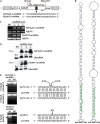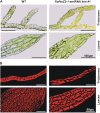Specific gene silencing by artificial MicroRNAs in Physcomitrella patens: an alternative to targeted gene knockouts
- PMID: 18753280
- PMCID: PMC2556843
- DOI: 10.1104/pp.108.128025
Specific gene silencing by artificial MicroRNAs in Physcomitrella patens: an alternative to targeted gene knockouts
Abstract
MicroRNAs (miRNAs) are approximately 21-nucleotide-long RNAs processed from nuclear-encoded transcripts, which include a characteristic hairpin-like structure. MiRNAs control the expression of target transcripts by binding to reverse complementary sequences directing cleavage or translational inhibition of the target RNA. Artificial miRNAs (amiRNAs) can be generated by exchanging the miRNA/miRNA* sequence within miRNA precursor genes, while maintaining the pattern of matches and mismatches in the foldback. Thus, for functional gene analysis, amiRNAs can be designed to target any gene of interest. The moss Physcomitrella patens exhibits the unique feature of a highly efficient homologous recombination mechanism, which allows for the generation of targeted gene knockout lines. However, the completion of the Physcomitrella genome necessitates the development of alternative techniques to speed up reverse genetics analyses and to allow for more flexible inactivation of genes. To prove the adaptability of amiRNA expression in Physcomitrella, we designed two amiRNAs, targeting the gene PpFtsZ2-1, which is indispensable for chloroplast division, and the gene PpGNT1 encoding an N-acetylglucosaminyltransferase. Both amiRNAs were expressed from the Arabidopsis (Arabidopsis thaliana) miR319a precursor fused to a constitutive promoter. Transgenic Physcomitrella lines harboring the overexpression constructs showed precise processing of the amiRNAs and an efficient knock down of the cognate target mRNAs. Furthermore, chloroplast division was impeded in PpFtsZ2-1-amiRNA lines that phenocopied PpFtsZ2-1 knockout mutants. We also provide evidence for the amplification of the initial amiRNA signal by secondary transitive small interfering RNAs, although these small interfering RNAs do not seem to have a major effect on sequence-related mRNAs, confirming specificity of the amiRNA approach.
Figures



Similar articles
-
Expression of artificial microRNAs in Physcomitrella patens.Methods Mol Biol. 2012;847:293-315. doi: 10.1007/978-1-61779-558-9_25. Methods Mol Biol. 2012. PMID: 22351018
-
Gene function analysis by artificial microRNAs in Physcomitrella patens.Methods Mol Biol. 2011;744:57-79. doi: 10.1007/978-1-61779-123-9_5. Methods Mol Biol. 2011. PMID: 21533686
-
Highly efficient virus resistance mediated by artificial microRNAs that target the suppressor of PVX and PVY in plants.Plant Biol (Stuttg). 2011 Mar;13(2):304-16. doi: 10.1111/j.1438-8677.2010.00374.x. Plant Biol (Stuttg). 2011. PMID: 21309977
-
Role of RNA interference (RNAi) in the Moss Physcomitrella patens.Int J Mol Sci. 2013 Jan 14;14(1):1516-40. doi: 10.3390/ijms14011516. Int J Mol Sci. 2013. PMID: 23344055 Free PMC article. Review.
-
MicroRNAs in the moss Physcomitrella patens.Plant Mol Biol. 2012 Sep;80(1):55-65. doi: 10.1007/s11103-011-9761-5. Epub 2011 Mar 4. Plant Mol Biol. 2012. PMID: 21373961 Review.
Cited by
-
Gene silencing using the recessive rice bacterial blight resistance gene xa13 as a new paradigm in plant breeding.Plant Cell Rep. 2012 May;31(5):851-62. doi: 10.1007/s00299-011-1206-8. Epub 2012 Jan 5. Plant Cell Rep. 2012. PMID: 22218673
-
A simple artificial microRNA vector based on ath-miR169d precursor from Arabidopsis.Mol Biol Rep. 2010 Feb;37(2):903-9. doi: 10.1007/s11033-009-9713-1. Epub 2009 Aug 20. Mol Biol Rep. 2010. PMID: 19693698
-
Polycistronic Artificial microRNA-Mediated Resistance to Cucumber Green Mottle Mosaic Virus in Cucumber.Int J Mol Sci. 2021 Nov 12;22(22):12237. doi: 10.3390/ijms222212237. Int J Mol Sci. 2021. PMID: 34830122 Free PMC article.
-
System for stable β-estradiol-inducible gene expression in the moss Physcomitrella patens.PLoS One. 2013 Sep 27;8(9):e77356. doi: 10.1371/journal.pone.0077356. eCollection 2013. PLoS One. 2013. PMID: 24086772 Free PMC article.
-
Undesired small RNAs originate from an artificial microRNA precursor in transgenic petunia (Petunia hybrida).PLoS One. 2014 Jun 4;9(6):e98783. doi: 10.1371/journal.pone.0098783. eCollection 2014. PLoS One. 2014. PMID: 24897430 Free PMC article.
References
-
- Aravin AA, Lagos-Quintana M, Yalcin A, Zavolan M, Marks D, Snyder B, Gaasterland T, Meyer J, Tuschl T (2003) The small RNA profile during Drosophila melanogaster development. Dev Cell 5 337–350 - PubMed
-
- Arazi T, Talmor-Neiman M, Stav R, Riese M, Huijser P, Baulcombe DC (2005) Cloning and characterization of micro-RNAs from moss. Plant J 43 837–848 - PubMed
-
- Axtell MJ, Bowman JL (2008) Evolution of plant microRNAs and their targets. Trends Plant Sci 13 343–349 - PubMed
-
- Axtell MJ, Jan C, Rajagopalan R, Bartel DP (2006) A two-hit trigger for siRNA biogenesis in plants. Cell 127 565–577 - PubMed
Publication types
MeSH terms
Substances
Associated data
- Actions
- Actions
LinkOut - more resources
Full Text Sources
Other Literature Sources
Molecular Biology Databases

